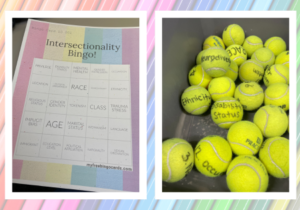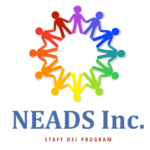Intersectionality Bingo
Intersectionality: The theory suggests and examines how biological, social and cultural categories such as gender, race, class, ability, sexual orientation, and other identities interact on multiple and often simultaneous levels, contributing to multiple forms of discrimination and systematic social inequality.
Ex: The experience of a middle class, heterosexual black woman is different than the experience of a lower class, gay, white woman despite the fact that they are both women.
- Race: A socially constructed concept which refers to groups of people that are categorized based on physical features like skin color and facial features. Race is considered something a person inherits. The U.S. Census recognizes 5 racial categories: American Indian, Asian, Black, White, Pacific Islander, Latin.
- Ethnicity: the quality or fact of belonging to a population group or subgroup made up of people who share a common cultural background or descent, typically marked by shared language, cultural practices, and beliefs. Ethnicity is something you acquire or inherit over time. Examples of ethnic groups include Vietnamese, Italian, Caribbean, or Mexican.
- Nationality: refers to where an individual is a legal citizen, usually in the country where they were born. Nationality does not typically encompass the acquired parts of cultural beliefs and practices.
- Immigrant: A person who comes to live permanently in a foreign country. For a U.S. context, an immigrant is an individual who lawfully enters the country but is not a U.S. citizen. The fact of being an immigrant shapes an individual’s experiences and interactions with society.
- Sexual orientation: a person’s inherent and immutable identity in relation to the gender or genders to which they are typically attracted. Sexual orientation is independent of a person’s gender identity.
- Gender Identity: One’s internal concept of self as male, female, a blend of both or neither including how someone perceive themself and what they call themself. One’s gender identity can be the same or different from their sex assigned at birth. If it is the same, the person is cisgender. If it is different, the person is transgender.
- Gender Expression: The external appearance or presentation of one’s gender identity, typically expressed through behavior, clothing and style, and body characteristics or voice. Gender expression can match an individual’s internal sense of gender identity, it can be different, or it can be a blend.
- Class: An economic grouping based on actual or perceived income and wealth. Upper class, middle class, and lower-class individuals have access to different resources and different experiences which contribute to their identity.
- Education Level: The extent of formal instruction or schooling a person has received ranging from no school completed to high school diploma to a bachelor’s degree to a doctoral degree.
- Neurodivergent: A term referring to people who brains develop or work differently that what is considered typical; this term is frequently used with reference to autistic spectrum disorders, ADHD, and learning disabilities such as dyslexia.
- Disability status: Refers to the presence of a condition of the body or mind that makes it more difficult for the person with the condition to do certain activities and interact with the world around them.
- Occupation – a person’s job or profession. There are differences across society in terms of how strongly a person correlates or doesn’t correlate their occupation with their identity.
- Trauma Status – refers to the presence or absence of a trauma event in an individual’s experience. Trauma events include abuse, violence, major accidents, loss, natural disasters, and war.
- Religious status – an individual’s understanding and relation to faith. Religious status could include anything from Islam, Christianity, Hinduism to Atheism or Agnosticism.
- Age – the number of years a person has been alive. Age can impact identity in terms of life stage status as well as generational.
- Mental health – a individual’s condition in regard to their psychological and emotional well-being. Mood disorders, substance abuse disorders, anxiety disorders, eating disorders and others can influence one’s identity and how they show up in the world.
- Language – refers to a system of written, spoken, or manual (signed) symbols used to communicate in a social group. A person’s native language, number of languages a person can communicate in, and which languages a person communicates in all impact who they are able to communicate with and how.
- Location: refers to the physical location where someone lives.
- Physical Appearance: refers to the external appearance of an individual. Factors like height, weight, body shape, even something like presence of tattoos can all shape someone’s identity and their experiences in society.
- Marital status: refers to whether a person is single, married, separated, divorced, or widowed.
- Political affiliation: refers to the political party or organization a person identifies with or supports. Examples in the U.S. democratic system include Republication, Democrat, Green Party, Independent but will differ in different countries and political systems.
- Privilege: A special right, advantage, or immunity granted or available only to a particular person or group. When identities intersect, a person may experience differing levels of privilege within different identities.
- Implicit Bias: an attitude or internalized stereotypes that unconsciously affect our perceptions, actions, and decisions. We may have implicit biases about some parts or multiple parts of a person’s identity.
- Womanism: A form of feminism focused especially on the experiences, conditions, and concerns of women of color, especially Black women. Womanism highlights how having 1 shared identity (in this case, being a woman) does not equate to shared experiences across the board.
- Tokenism: The practice of doing something (such as hiring a person who belongs to a minority group) only to prevent criticism and give the appearance that people are being treated fairly instead of working to change systems that are disadvantaging people of certain identities.

